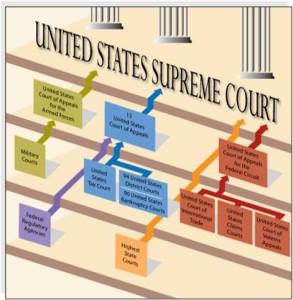The Path to Judicial Justice Begins with the Supreme Court
Article III, Section 2 of the U.S. Constitution states that “The judicial Power of the United States, shall be vested in one Supreme Court, and in such inferior Courts as the Congress may from time to time ordain and establish.” During and immediately after the Reconstruction, the courts provided a means for African Americans to redress expoitation and abuse. Many were successful in redressing civil claims:
“At the height of Jim Crow, Lurena Roebuck successfully pursued a case against John Leonard before the local county court and received a decision invalidating his claim to her land. When the white man appealed the lower court’s decision, she defended her claim in the Supreme Court of Alabama and once again received a decision in her favor.” See Rethinking the Role of the Courts in the Lives of Black Southerners by Melissa Milewski.

In cases that took place after the end of Reconstruction (1878 to 1899), black Southerners won 56 out of 102 of their suits (55%)._____________________ (From Slave to Litigant: African Americans in Court in the Postwar South, 1865-1920). Today we have no idea of what percentage of African Americans prevail in civil cases. Anecdotal evidence collected during ONUS’s Focus on the Judiciary forum revealed troubling patterns and questionable decisions by a number of judges on civil cases brought by African American litigants. Documents presented during the forum revealed cases where judges bent or ignored precedent to justify inexplicable decisions. The anecdotal data showed a direct correlation between diminished wealth profile and judicial inequity. ONUS concluded that lack of judicial access and what appears to be racial bias in decision making contributes significantly to African Americans being at least thirteen times less wealthy than their white counterparts.
The effort to address racial discrimination in civil courts must begins with a restructuring of the U.S. Supreme Court
Racially-based decisions burden the entire judicial system. Litigants denied redress by racially biased judges are forced to climb the judicial ladder, motion by motion, appeal by appeal, in search of arbiters who will decide their matter based upon an impartial examination of facts. The U.S. Supreme Court creates law and reaffirms existing law when it reviews lower court decisions on civil matters. A fixed number of justices and ever-expanding case load have rendered the most powerful court in the nation accessible to a few. Each year, the Supreme Court reviews only about 100-150 of the approximately 7000 cases filed. Most cases are filed by states, powerful corporations, and other litigants that wield significant power and possess abundant financial resources.
Granting Supreme access to a select few degrades the entire judiciary. Lower court judges can operate with impunity: There is little to know change of having a case reviewed by the high court and there are no procedures for calling attention to a judgment that wreaks of racial animus. Thus, racially-based decisions intended to deny African Americans financial redress are easily concealed as valid judicial decisions that can only be addressed through the appeals process, which is ill-equipped to distinguish racially-based assaults from mere opinions. Further complicating matters, is the unwillingness of some judges to overturn a lower judge’s decision.
According to Alexander Hamilton, “[T]hrough the practice of judicial review the Court ensured that the will of the whole people, as expressed in their Constitution, would be supreme over the will of a legislature [and corporations and the nation’s wealthiest], whose statutes might express only the temporary will of part of the people.” How can the court determine the will of the people if it does not hear from the people. The time has come for a greater focus on the judiciary, specifically as it relates to African-American litigants. The following are changes citizens must pursue:
- Require court case statistics by race and gender so Americans will know how African Americans are fairing on civil cases in comparison to others.
- Create mechanisms of accountability and oversight.
- Increase the number of justices and divide the justices into sub-panels —each one charged with deciding topics by subject matter.
- Establish mechanisms for challenging decisions as racially biased.